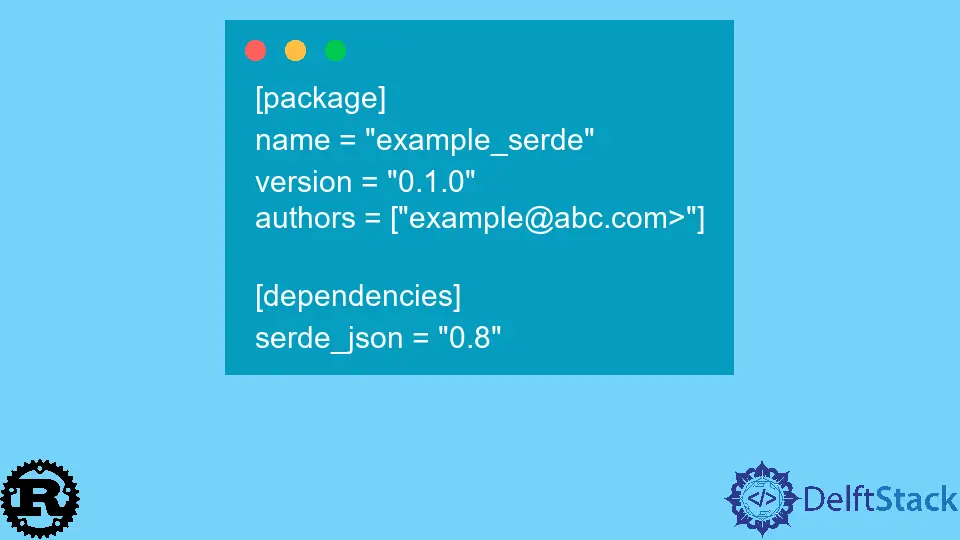How to Use Serde to Serialize Structs Containing Ndarray Fields
- Understanding Serde and Ndarray
- Setting Up Your Rust Environment
- Defining Your Struct with Ndarray Fields
- Serializing the Struct
- Deserializing the Struct
- Conclusion
- FAQ

In the world of Rust programming, the ability to efficiently serialize and deserialize data structures is essential. This is especially true when dealing with complex types like structs that contain Ndarray fields. Serde, a powerful serialization framework in Rust, makes this process straightforward and efficient.
In this tutorial, we’ll explore how to use Serde to serialize and deserialize structs containing Ndarray fields. By the end of this article, you’ll have a solid understanding of how to leverage Serde for your data serialization needs, ensuring your Rust applications can easily handle multidimensional arrays.
Understanding Serde and Ndarray
Before diving into the code, it’s important to understand what Serde and Ndarray are. Serde is a framework that provides a way to convert Rust data structures into a format that can be easily stored or transmitted, such as JSON or binary. Ndarray, on the other hand, is a Rust library for N-dimensional arrays, similar to NumPy in Python. Combining these two libraries allows you to serialize complex data structures seamlessly.
Setting Up Your Rust Environment
To get started, you’ll need to set up your Rust environment. Make sure you have Rust installed, and then create a new project. You can do this using the following command:
cargo new serde_ndarray_example
cd serde_ndarray_example
Next, you’ll want to add the necessary dependencies to your Cargo.toml file. You’ll need serde, serde_json, and ndarray. Your Cargo.toml should look something like this:
[dependencies]
serde = { version = "1.0", features = ["derive"] }
serde_json = "1.0"
ndarray = "0.15"
This setup will allow you to use Serde for serialization and Ndarray for handling multidimensional arrays.
Defining Your Struct with Ndarray Fields
Now that your environment is set up, let’s define a struct that contains an Ndarray field. Here’s an example:
use ndarray::Array2;
use serde::{Serialize, Deserialize};
#[derive(Serialize, Deserialize, Debug)]
struct Data {
name: String,
values: Array2<f64>,
}
In this code, we define a struct Data that has a name field of type String and a values field that is a 2D array of type Array2<f64>. The #[derive(Serialize, Deserialize)] attribute enables automatic serialization and deserialization for our struct.
The Serialize and Deserialize traits are crucial here, as they allow our struct to be converted to and from a format like JSON.
Serializing the Struct
Now that we have our struct defined, let’s serialize an instance of it. Here’s how you can do this:
fn main() {
let data = Data {
name: String::from("Sample Data"),
values: Array2::zeros((3, 3)),
};
let serialized = serde_json::to_string(&data).unwrap();
println!("Serialized: {}", serialized);
}
When you run this code, it creates an instance of Data, initializes the values field with a 3x3 array of zeros, and then serializes it to a JSON string.
Output:
Serialized: {"name":"Sample Data","values":[[0.0,0.0,0.0],[0.0,0.0,0.0],[0.0,0.0,0.0]]}
The output shows the serialized JSON representation of the Data struct. This format is easy to transmit over networks or store in files.
Deserializing the Struct
Deserialization is just as straightforward. Let’s take the serialized JSON string from the previous example and convert it back into a Data struct:
fn main() {
let json_data = r#"{"name":"Sample Data","values":[[0.0,0.0,0.0],[0.0,0.0,0.0],[0.0,0.0,0.0]]}"#;
let deserialized: Data = serde_json::from_str(json_data).unwrap();
println!("Deserialized: {:?}", deserialized);
}
In this snippet, we have a JSON string and we use serde_json::from_str to convert it back into a Data struct. The output will show the deserialized struct.
Output:
Deserialized: Data { name: "Sample Data", values: Array2 { shape: [3, 3], data: [0.0, 0.0, 0.0, 0.0, 0.0, 0.0, 0.0, 0.0, 0.0] } }
The output confirms that our JSON string has been successfully converted back into a Rust struct, complete with the Ndarray field populated as expected.
Conclusion
Using Serde to serialize and deserialize structs containing Ndarray fields in Rust is a powerful technique that simplifies data handling in your applications. With just a few lines of code, you can convert complex data structures into formats that are easy to work with, whether you’re saving to a file or transmitting over a network. By following the steps outlined in this tutorial, you can effectively integrate Serde and Ndarray into your Rust projects.
FAQ
-
What is Serde in Rust?
Serde is a framework for serializing and deserializing Rust data structures, allowing them to be easily converted to formats like JSON. -
What is Ndarray in Rust?
Ndarray is a Rust library for N-dimensional arrays, similar to NumPy in Python, enabling efficient handling of multi-dimensional data. -
How do I set up Serde and Ndarray in my Rust project?
You can set them up by adding the respective dependencies to yourCargo.tomlfile and then using them in your code. -
Can I serialize other data types with Serde?
Yes, Serde can serialize a wide range of data types, including primitive types, collections, and custom structs. -
What output formats can Serde work with?
Serde can work with various formats, including JSON, BSON, YAML, and more, depending on the serialization library you use.